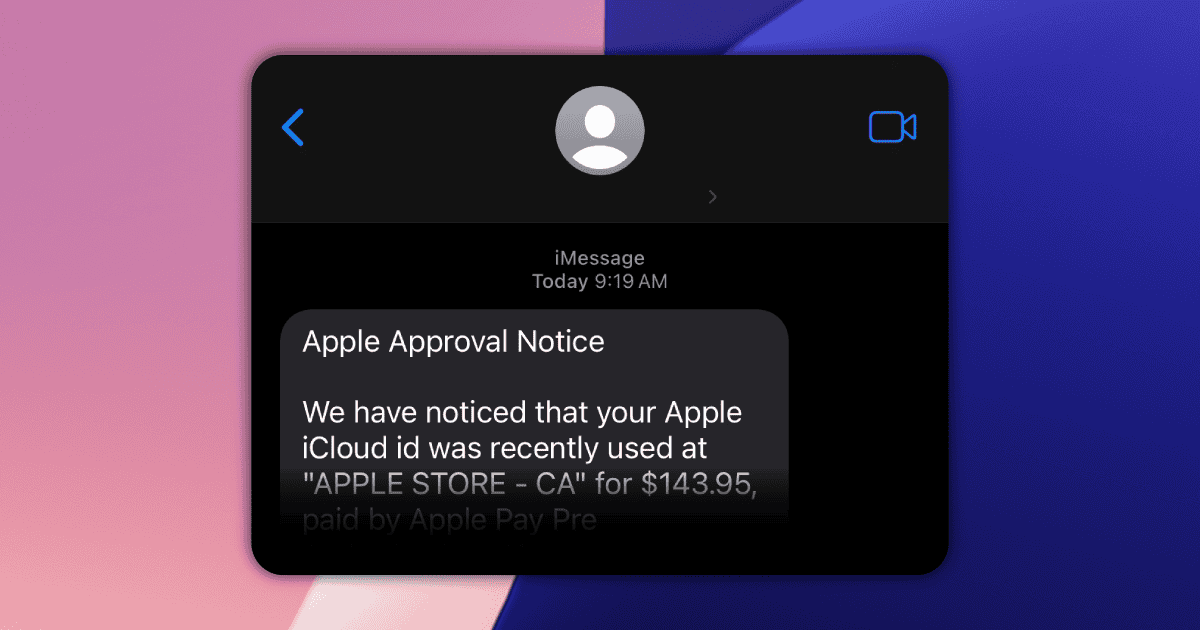
- a problem with one of your accounts or services
- a package that can't be delivered
- an invoice/receipt for an item or service which you didn't order
- a refund or rebate owed to you
- a prize you've won
- a ticket issued to you


















- Search emails for financial information, invoices and supplier details
- Set up hidden forwarding rules to monitor future messages
- Attempt password changes or privilege escalation
- Access OneDrive, Teams and SharePoint data
- Send further phishing emails from the compromised account
- Prepare ransomware deployment or delete backups
- Check the sender before you click. Look closely at who the email is really from. A slight misspelling, an unexpected attachment or wording that feels off is a big clue the message may be fake.
- Hover over links first. Before you open any link, hover your mouse over it to preview the URL. If it does not lead to the official Microsoft login page or looks odd in any way, skip it.
- Turn on multifactor authentication (MFA). MFA adds an extra layer adds an extra layer that makes it much harder for attackers to break in even if they have your password. Use options like app-based codes or hardware keys so phishing kits cannot bypass them.
- Update your browser and apps. Keep everything on your device up to date. Updates seal off security holes that attackers often rely on when building phishing kits like QRR.
- Never click unknown links and use strong anti-malware software. If you need to visit a sensitive site, type the address into your browser instead of tapping a link. Strong anti-malwsare software like Malwarebytes Premium also help by warning you about fake websites and blocking scripts that phishing kits use to steal login details.

















































From: "I hacked you!" <alanperry107@peoplepc.com>Hello pervert, I've sent this message from your iCloud mаil, and I have included a picture of where you live, so you know I know who you are.I want to inform you about a very bad situation for you. However, you can benefit from it, if you will act wisеly.Have you heard of Pegasus? This is a spyware program that installs on computers and smartphones and allows hackers to monitor the activity of device owners. It provides access to your webcam, messengers, emails, call records, etc. It works well on Android, iOS, and Windows. I guess, you already figured out where I’m getting at.It’s been a few months since I installed it on all your dеviсеs because you were not quite choosy about what links to click on the intеrnеt. During this period, I’ve learned about all aspects of your private life, but оnе is of special significance to me.I’ve recorded many videos of you jerking off to highly controversial роrn videos. Given that the “questionable” genre is almost always the same, I can conclude that you have sick реrvеrsiоn.
I doubt you’d want your friends, family and co-workers to know about it. However, I can do it in a few clicks.Every number in your contact Iist will suddenly receive these vidеоs – on WhatsApp, on Telegram, on Instagram, on Facebook, on email – everywhere. It is going to be a tsunami that will sweep away everything in its path, and first of all, your fоrmеr life.
Don’t think of yourself as an innocent victim. No one knows where your реrvеrsiоn might lead in the future, so consider this a kind of deserved рunishmеnt to stop you.I’m some kind of God who sees everything. However, don’t panic. As we know, God is merciful and forgiving, and so do I. But my mеrсy is not free.Transfer 1400 USD to my Litecoin (LTC) wallet: ltc1qhelugumywjk7vwq3h3488j082mh4g242d0sl34Once I receive confirmation of the transaction, I will реrmanently delete all videos compromising you, uninstаll Pegasus from all of your devices, and disappear from your life. You can be sure – my benefit is only money. Otherwise, I wouldn’t be writing to you, but destroy your life without a word in a second.I’ll be notified when you open my email, and from that moment you have exactly 48 hours to send the money. If cryptocurrencies are unchartered waters for you, don’t worry, it’s very simple. Just google “crypto exchange” or "buy Litecoin" and then it will be no harder than buying some useless stuff on Amazon.I strongly warn you against the following:
* Do not reply to this email. I've sent it from your iCloud mail.* Do not contact the police. I have access to all your dеviсеs, and as soon as I find out you ran to the cops, videos will be published.* Don’t try to reset or destroy your dеviсеs. As I mentioned above: I’m monitoring all your activity, so you either agree to my terms or the vidеоs are рublished.Also, don’t forget that cryptocurrencies are anonymous, so it’s impossible to identify me using the provided аddrеss.Good luck, my perverted friend. I hope this is the last time we hear from each other.And some friendly advice: from now on, don’t be so careless about your online security.
From: "I hacked you!" <brianpavlici@peoplepc.com>
Hello pervert, I've sent this message from your iCloud mаil.I want to inform you about a very bad situation for you. However, you can benefit from it, if you will act wisеly.Have you heard of Pegasus? This is a spyware program that installs on computers and smartphones and allows hackers to monitor the activity of device owners. It provides access to your webcam, messengers, emails, call records, etc. It works well on Android, iOS, and Windows. I guess, you already figured out where I’m getting at.It’s been a few months since I installed it on all your dеviсеs because you were not quite choosy about what links to click on the intеrnеt. During this period, I’ve learned about all aspects of your private life, but оnе is of special significance to me.I’ve recorded many videos of you jerking off to highly controversial роrn videos. Given that the “questionable” genre is almost always the same, I can conclude that you have sick реrvеrsiоn.
I doubt you’d want your friends, family and co-workers to know about it. However, I can do it in a few clicks.Every number in your contact Iist will suddenly receive these vidеоs – on WhatsApp, on Telegram, on Instagram, on Facebook, on email – everywhere. It is going to be a tsunami that will sweep away everything in its path, and first of all, your fоrmеr life.
Don’t think of yourself as an innocent victim. No one knows where your реrvеrsiоn might lead in the future, so consider this a kind of deserved рunishmеnt to stop you.I’m some kind of God who sees everything. However, don’t panic. As we know, God is merciful and forgiving, and so do I. But my mеrсy is not free.Transfer 1400 USD to my Litecoin (LTC) wallet: ltc1qhelugumywjk7vwq3h3488j082mh4g242d0sl34Once I receive confirmation of the transaction, I will реrmanently delete all videos compromising you, uninstаll Pegasus from all of your devices, and disappear from your life. You can be sure – my benefit is only money. Otherwise, I wouldn’t be writing to you, but destroy your life without a word in a second.I’ll be notified when you open my email, and from that moment you have exactly 48 hours to send the money. If cryptocurrencies are unchartered waters for you, don’t worry, it’s very simple. Just google “crypto exchange” or "buy Litecoin" and then it will be no harder than buying some useless stuff on Amazon.I strongly warn you against the following:
* Do not reply to this email. I've sent it from your iCloud mail.* Do not contact the police. I have access to all your dеviсеs, and as soon as I find out you ran to the cops, videos will be published.* Don’t try to reset or destroy your dеviсеs. As I mentioned above: I’m monitoring all your activity, so you either agree to my terms or the vidеоs are рublished.Also, don’t forget that cryptocurrencies are anonymous, so it’s impossible to identify me using the provided аddrеss.Good luck, my perverted friend. I hope this is the last time we hear from each other.And some friendly advice: from now on, don’t be so careless about your online security.





























































































www.grc-rcmp.gc.ca
Ontario RCMP shuts down prolific Cyber-fraudsters | Royal Canadian Mounted Police
Two Toronto residents are facing criminal charges after allegedly defrauding hundreds of Canadian victims out of millions of dollars. The couple are believed to have used technology that allowed them to conceal their phone number in order to pose as bank, government or police employees to deceive their victims and trick them out of their hard-earned savings.



















The Mac Security Blog
Google phishing scam e-mail deploys diabolical deceptions - The Mac Security Blog
A highly sophisticated phishing e-mail campaign is exploiting Google’s own services; Google itself is sending scam e-mails on behalf of fraudsters, and linking to Google-hosted phishing sites. Here’s what to watch out for so you don’t fall victim to this scam.

andrew chen on Twitter / X
6) If I click "View case" then it shows me this fake signup page. Again, hosted on Google Sites.Given that it's not a popular website, I could absolutely see people falling for thisA bunch of things were off:- the email wasn't addressed to me, it was some weird email… pic.twitter.com/VCmaJxJ0vX— andrew chen (@andrewchen) April 14, 2025












- Fabricated Lab Results and Customer Reviews: The product’s website showcases supposed laboratory tests and glowing testimonials, all of which are fabricated to build credibility.
- Social Media Advertising: Platforms like Facebook, YouTube, and TikTok are flooded with ads and videos demonstrating dramatic reductions in electricity bills after using ESaver Watt. These are staged and misleading.
- Fake Celebrity Endorsements: The device is falsely associated with tech moguls like Elon Musk and Mark Cuban, suggesting their endorsement to gain trust.
- Bogus News Reports: Fake articles on spoofed news websites claim that ESaver Watt has been featured on reputable media outlets, further deceiving potential buyers.



- it comes unexpectedly from an unknown number
- it asks for personal info or requests you click a link
- it creates a sense of urgency
- it claims they are from a trusted business or bank to appear legitimate
- Verify the sender by contacting them through another medium, like the phone number on the official website
- Never click on suspicious links
- Delete smishing messages and block the number
- Ignore texts even if they ask to reply with "STOP" or "NO"
- Flag spam texts by forwarding them to 7726 (SPAM), to help your cellular provider investigate further
- Report suspicious texts. If you believe you’ve come across smishing, report it to Canadian Anti-Fraud Centre
Government of Canada
Ding! Scammers are hiding in your text messages
Phones are constantly buzzing, and scammers know the easiest way to you is through your text messages. Lately, many people are seeing more text messages from unknown numbers, saying things like “Unpaid highway toll detected on your vehicle. Pay now to avoid fines.” or “We’ve detected suspicious activity on your account – verify now”. Be on the lookout: it could be a common scam known as smishing.









The moment you log in with the credentials from that DM, a glossy, mobile-friendly dashboard flashes a huge balance. There’s motion (numbers “update”), a believable “history,” and a big Withdraw button right where your thumb expects it. On a small screen, it looks like a real account with real money…

When you try to send that balance to your own wallet, the site asks for a withdrawal key belonging to the original account holder — the one from the DM. You don’t have that key, and Support won’t give it to you. External withdrawals are a dead-end by design.

Support suggests using Internal Transfer instead. Conveniently, they also offer to help you create a new user “in seconds,” and this new account will have its own key (because you created it). That makes it feel like you’re finally doing something legitimate: “I’ll just transfer the funds to my new account and then withdraw.”

But then, you discover that internal transfers only work on “VIP” accounts. To upgrade to VIP, you must pay for a membership. Many victims pay here, assuming it’s a one-time hurdle before they can finally withdraw…

After you upgrade and attempt the internal transfer, the site can:
- demand another fee (a “limit lift,” “tax,” or “security key”),
- fail silently and push you to support, or
- “complete” the transfer inside the fake ledger while still blocking any external withdrawal.
- The balance looks real, so every new hurdle feels like bureaucracy, not fraud.
- Paying once creates sunk cost: “I’ve already invested—one more step and I’m done.”
- Internal movements inside their dashboard mimic progress, even though no on-chain transfer ever occurs.
- A mobile flow encourages momentum—it’s always “one more tap” to finish.







- Go to Outlook.com, and sign in with your Microsoft Account.
- Look for a gear icon at the top right, and click on it to open the Settings menu.
- Then click on Mail on the left, and then on Events from Email..

- In the box that appears, on the right, change the Settings for each of the categories to Don't Show…




- Open Settings → Security & privacy → More security & privacy.
- Tap SIM lock.
- Toggle Lock SIM card on.
- Choose a PIN (4-8 digits)
- Open Settings → Connections → SIM manager.
- Tap More SIM settings → SIM card security.
- Toggle Lock SIM card on.
- Choose a PIN (4-8 digits)
- Default PINs: Carriers often ship SIMs with a default PIN (commonly
0000or1234).
- Wrong attempts: Entering the wrong PIN three times will block the SIM. You’ll need a PUK code (Personal Unblocking Key) from your carrier to unlock it.




























